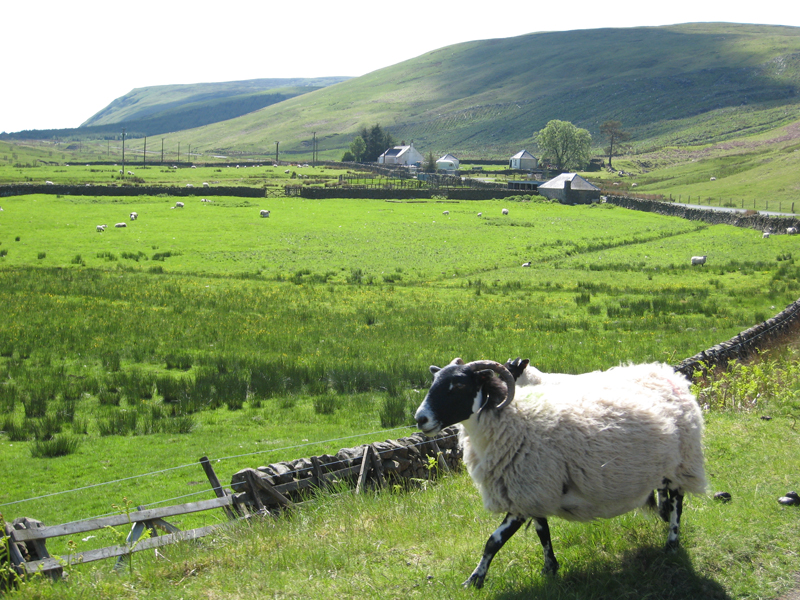
In 2008, when my husband and I visited Scotland for the first time, our tour guide took us to view Grey Mare’s Tail, a waterfall high in a pass between the hills of Dumfries and Galloway in southwest Scotland. I scrambled a short distance up the rocky path leading to the waterfall and photographed a couple of sheep that had wandered onto the road. It was a beautiful spot, but I remarked that this would be a pretty remote place to live. I had no idea that some of my ancestors had actually lived in the nearby parish of Westerkirk.
I knew that my great-grandmother’s name was Isabella Glendenning. She was born in Scarborough, Upper Canada in 1834, married James Hamilton in 1859 and died in Winnipeg, Manitoba in 1912. When I researched her ancestry, I discovered that one of my distant relatives, Ian Glendinning, a genealogist in Aberdeen, Scotland, had spent years researching the Glendinning family. (At some point, the spelling of Isabella’s family name changed.)
The enormous family tree he has posted online (http://www.glendinning.name/index.html) shows that our ancestors lived in and around Westerkirk parish, Dumfriesshire, as long ago as the 1600s. There is a place named Glendinning and the ruins of a castle named Glendinning, but my ancestors were labourers and tenant farmers.
According to the Statistical Accounts of Scotland, in 1793 the population of the parish was 655 people (150 of whom were under 20 years of age) and 17,500 sheep. There was good pasture for sheep on the hillsides and the light loam in the river valleys produced good crops if it was well managed. The main crops grown were oats, barley, peas and potatoes.
The church, built in 1788 and located near the center of the parish, was said to be one of the best country churches in Scotland at that time. There was a school next to the church and the church also provided money to help the area’s poorest residents. The parish roads were good and there were 16 stone bridges across various streams and rivers.
According to the Glendinning family tree, James Glendinning (born 1676) and Agnes Little (born c. 1680) were married in Westerkirk in 1701 and had seven children. My direct ancestor was their second son, Archibald (1704-1751). He was an elder of Westerkirk parish church, and he and his wife, Jean Beattie (1724-1773), probably lived their entire lives in Westerkirk.
Although Westerkirk parish has an area of just 110 sq. km (42 sq. miles) and many place names simply refer to farms or landmarks, its residents often moved. My direct ancestor James Glendinning (b. 1738), the youngest of Archibald’s and Jean’s five children, was a labourer in Meikleholm in neighbouring Langholm parish, then he moved to Broomholm where he was a tenant farmer. Eventually he became a tenant of Johnstone of Westerhall estate at Glendinning, Westerkirk, selling the lease in 1809 when he was probably too old to manage the farm.
James married Isabel Beattie (1737-1815), daughter of Walter Beattie and Marion Black, and they had eight children and 43 grandchildren. James died in 1810, and he and Isabel are buried in Westerkirk parish cemetery.
James’ and Isabel’s fourth child, Walter (b. 1770), my direct ancestor, also moved around the area. Walter married Elizabeth Park in 1794 in Westerkirk. Four of their children were baptized at Glendinning, while four more were born at Craig, where Walter may have been a farm labourer. It is not clear where their youngest daughter, Margaret, was born.
James and Isabel’s children were the first generation to leave Westerkirk for Canada. Mary Glendinning (1768-1847) and her husband David Thomson settled in Scarborough, Upper Canada (now a suburb of Toronto, Ontario) in 1799; Walter Glendinning probably accompanied his children, who settled in Scarborough 20 years later; James Glendinning (1774-1856) moved to Streetsville in Upper Canada; William Glendinning (1777-1866), settled in New Brunswick. James and Isabel’s four other children remained in the Westerkirk region.
In my next post, I will write about how the Glendinnings were finally able to buy land of their own in Canada.
This post was revised Dec. 5 2016 to add information.
Notes and Sources:
You can find a map of the area in John Thompson’s Atlas of Scotland 1832, National Library of Scotland, http://maps.nls.uk/atlas/thomson/555.html. See also http://www.glendinning.name/views/megdale/index.htm and A Vision of Britain through Time, http://www.visionofbritain.org.uk/place/16676.
James Glendinning and Agnes Little are at http://www.glendinning.name/ancestry/glenfam/pafg01.htm#320 on Ian Glendinning’s family tree. From here, you can use the arrows to skip to other generations, consult the list of names or go back to the home page. The site also includes some photos and a map. Ian found details about these peoples’ lives through parish records of baptisms and marriages, the Kirk Sessions of Westerkirk and newspapers.
“Westerkirk, County of Dumfries, OSA, Vol. XI, 1794”, Statistical accounts of Scotland, 1791-1854, p.514-519, http://stataccscot.edina.ac.uk/static/statacc/dist/home, accessed Dec. 2, 2016.
See Ian D. Whyte, “Written Leases and their Impact on Scottish Agriculture in the Seventeenth Century”, http://www.bahs.org.uk/AGHR/ARTICLES/27n1a1.pdf.
The website of the Grey Mares Tail Nature Reserve: http://www.nts.org.uk/Property/Grey-Mares-Tail-Nature-Reserve/Pictures/
Westerkirk’s most famous son was Thomas Telford (1757-1834), a civil engineer who built roads, bridges and canals throughout Scotland and England, and the famous Menai Suspension Bridge in Wales. He was not related to my family.
